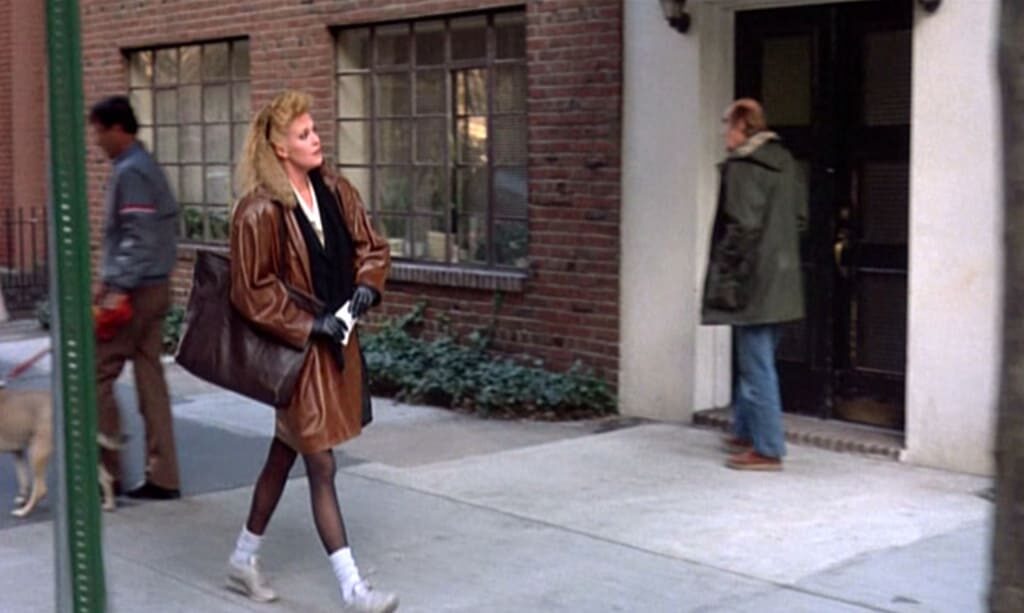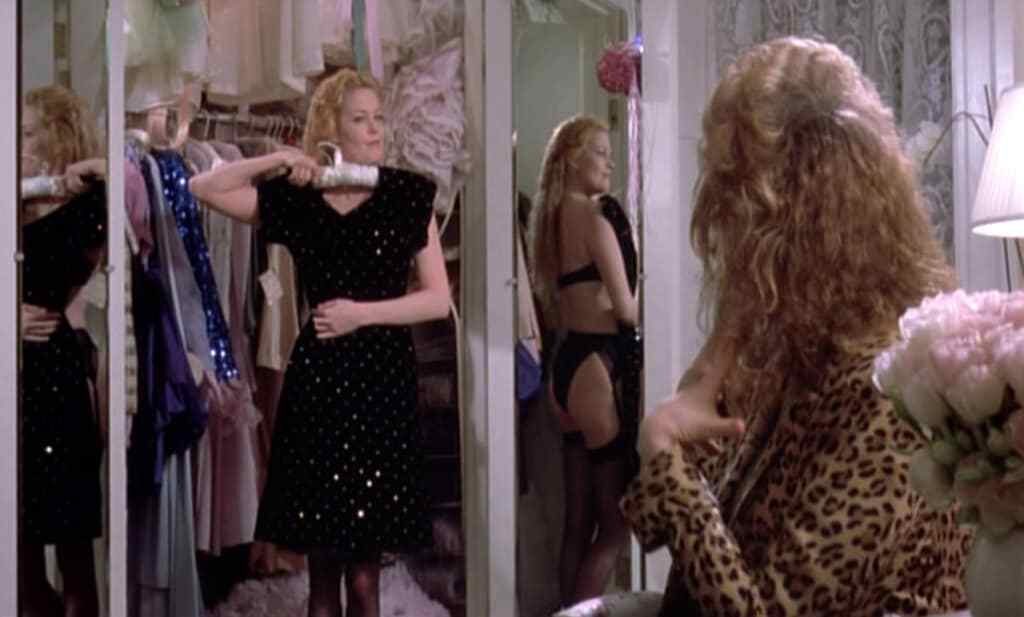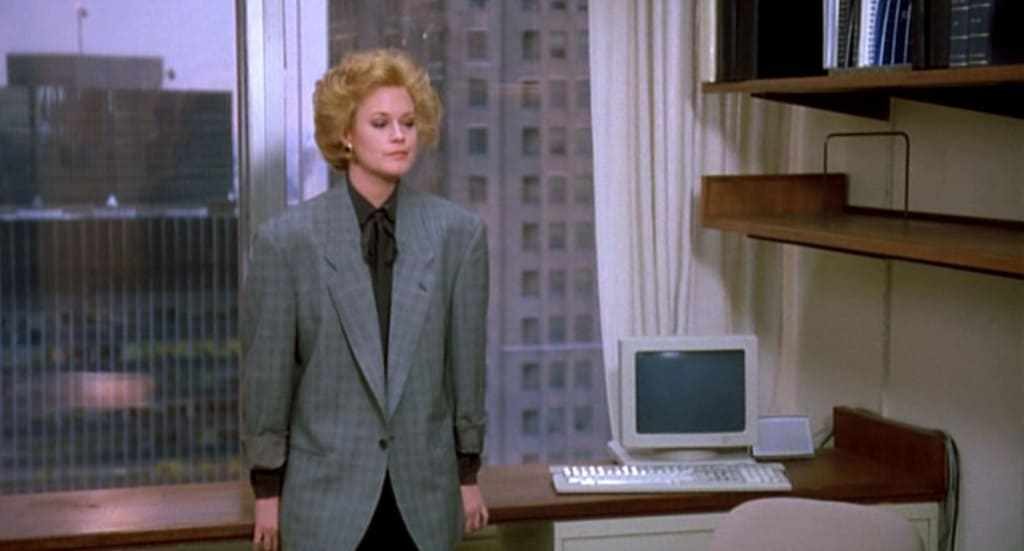Working Girl: The Culture of Power Dressing | Clothes on Film – Part 33183
Costume designer Ann Roth’s template for Working Girl (1988, directed by Mike Nichols) is especially astute with regards to the social and geographical make up of its characters. Protagonist Tess McGill (Melanie Griffith) is a homely girl raised and living in Staten Island, New York. Currently working as a secretary in Manhattan (not ‘executive assistant’, reflecting vernacular of the time), as is her best friend Cynthia (Joan Cusack). Tess, however, has gained a degree through night school and harbours ambitions to use it for more constructive tasks than answering the telephone and fetching toilet paper for bawdy stockbrokers. After being set up for a ‘date’ that turned out to be the office equivalent of the Hollywood casting couch, Tess loses her job but gets one last chance as secretary to new-in-town Boston businesswoman, Katherine Parker (Sigourney Weaver).
Tess journeys across the Hudson River into Manhattan every day, like so many others, aboard the Staten Island Ferry. It was here that Ann Roth observed the attire of secretaries travelling into the city. With the benefit of hindsight, the clothes these girls wear; the stripy tights and copious leather, cheap gold jewellery and enough make-up to open a cosmetics counter, appears ludicrously OTT. And yet this is actually what they wore. In general, fashions by the close of the 1980s were more grown-up and sober, but outside of metropolitan areas many trends still hung on several years past their best before date.


The costumes in Working Girl arc around one central premise: power dressing. As Tess grows in determination, her clothes evolve past the copied ensembles she has literally stolen from her recuperating, though backstabbing boss into her own interpretation of the New York ‘look’. The power suit was a formidable garment. Wide shoulders were the key detail, jacket tailored and fitted, along with knee length skirt and plain shirt. Taken directly from the male wardrobe, this look was filtered down from couture by Giorgio Armani. Incorporating fine lines from luxury materials (cashmere was popular); by mid-decade the Armani name had became interchangeable with the power suit.
Power dressing in the film is exemplified by ‘superboss’ Katherine. Tess attempts to imitate Katherine, and arguably these particular clothes pave the way for her new job at the end of the story. Yet Katherine is not as New York as Tess, not as brassy. Her strength comes more via form, i.e. the size of her shoulder pads. The eighties was a battleground for those who possessed the widest shoulder pads, for they would own the room. Tess emulates this idea by attending her appointment with Jack Trainer (Harrison Ford) wearing almost the exact same outfit as Katherine for their introduction.


Katherine advises Tess, “Dress shabbily, they notice the dress. Dress impeccably, they notice the woman – Coco Chanel”. Katherine is thrilled she can mention Chanel; one gets a feeling that she may not have used this quote otherwise. Though, in context, Chanel makes perfect sense. She was originator of functional attire for women sixty years before, basing her entire philosophy around subverting established attitudes toward femininity.
When Tess and Katherine meet they could not look more different. Tess wears a black rollneck sweater, black wool jacket with padded shoulders and tweedy grey skirt. For Tess this is restrained, as in previous scenes we have already seen her in polka dot tights, a tight houndstooth skirt featuring exposed zip and tan leather coat with huge raglan sleeves. Yet despite any comparative restraint, stood facing Katherine who looks the model of business elegance in mid-grey collarless silk jacket with padded shoulders and matching just above the knee skirt, plain white top and light grey trench coat, Tess is still stylistically poles apart. Katherine is not full on power dressing, as such, but she exudes professionalism.


Their first encounter is prefaced by a brief scene of Tess at home with her boyfriend. She is trying on the birthday underwear he bought her, a red bra, stockings and suspenders set, and comments that it would be nice to have a present she could “wear outside of the apartment” for once. At the time, Tess considers such intimate ensembles only for a ‘special occasion’, never at work or in a social setting. A few scenes later she is foraging a sparkly black dress from Katherine’s closet wearing that very same style of underwear. What once was so cheap is now the epitome of chic.
Ever perceptive, Ann Roth exposed an element of dressing in the lower echelons of business that is still prevalent for women today; the wearing of trainers on the hike to and from work. This is deeply unflattering, though practical as shoes donned inside the office were often statuesque heels. Once up the ranks however heels were still worn; another way for women to remain visible among largely male management teams. Attitudes had moved on since the sexism of the Mad Men era, but not enough that a woman’s clothes didn’t have to make half the introduction for her.


Yet roguish Jack Trainer is a role reversal. He is fetishised by women, although only those in an inferior hierarchical position, as a sex object. He hates clothes, discarding his shirt whenever he can by ripping off the buttons or dumping it nonchalantly on the floor. He is unorthodox; ogled through open blinds by a mob of secretaries (surely the inspiration for those infamous Diet Coke commercials?), Trainer is happy to go along with the joke. However, it is far easier for a man to have a sense of humour about such issues being as they were not openly objectified in the workplace. Working Girl plays a fun switcheroo but it hits a false note, especially when Trainer pleads with Tess to be taken seriously in their business deal. Trainer is only able to laugh at himself when he is in control.
Secretaries in the movie are mainly portrayed as young and energetic, if not especially enthusiastic and ambitious, apart from Tess of course. Their clothes are probably what most people will remember from Working Girl. Some quite shockingly bad taste outfits, including leopard skin print jackets, block stripe tights and copious baggy leather outerwear, often worn with ginormous hoop earrings or all gold accessories. Katherine advices Tess to cut back on her jewellery and she does so. Despite this, Katherine is often seen wearing gold jewellery herself, although of a much higher quality (i.e. real). Plus there is the inherent irony that Chanel, Katherine’s lifestyle inspiration, practically invented costume jewellery during the 1920s.


‘Inheriting’ Katherine’s job title, Tess follows what she believes is the model for classic dress – that less is more. Yet this is Tess’ own interpretation of the concept, so outside of straight copying a look from Katherine, e.g. collarless suit and cutting her hair into a sensible bob, she often confuses occasions by mixing formal work with evening glamour. It does not help that Cynthia barks comments such as, “It needs some bows or something” or “$6,000?! It’s not even leather!” as Tess is assembling her look. Being chic is not easy for her.
Wearing a black sparkly dress with full length dark brown fur coat to a drinks meeting was frowned upon as just too much, even though it attracts the attention of Trainer because Tess is “the first woman here that dresses like a woman, not like a woman would think a man would dress if he was a woman”. She is arguably more true to herself now than in the long, loose grey Glencheck jacket worn during the story’s final pay off. Quite possibly Tess’ most embarrassing moment of misjudgement is wearing white to another woman’s wedding. She is only there for the reception, but in certain social circles this is simply not done.


However by the point Katherine returns to her job Tess has grasped a few of the basics. Conforming to the style philosophy of Comme des Garçons (the label itself had undergone reinvention by the late eighties), Tess keeps things uncomplicated and co-ordinated in plain black single breasted suit with padded shoulders and white shirt – one very similar to Katherine’s, though with collar embellishment instead of pleats.
When the script’s last major turning point arrives, with Tess exposed by Katherine then having to return to the office to collect her possessions, she is dressed in a scrappy grey raglan sweater and pale jeans. At this point, Tess cannot even muster enthusiasm to be her old self. She is confronted by Katherine wearing a vivid red suit jacket. Katherine likes to use this colour to project authority, having already used Tess as a dogsbody during her ‘dim sum’ reception while hogging the room in a red pleated dress.


Yet in managing to turn the tables on immaculate Katherine, close the deal and secure a new job, all the while wearing a pair of fraying jeans, Tess has bucked the system. It does not matter what you wear, business is business whether in a suit or sandals (something that Facebook creator Mark Zuckerberg would attest to). What a pity then that for the last scene of the movie Tess is wearing possibly her most conformist outfit yet of oversized grey jacket with rolled-up sleeves and brown pussy bow blouse. So she attains her ideal job, by fair means or foul, but at what cost? Did Tess really achieve her dream, the supposed American dream, or just become another faceless drone in a suit? Perhaps the ‘boxed in’ framing of her office in the final shot says it all really.
© 2013 – 2018, Lord Christopher Laverty.